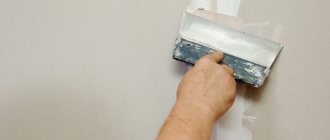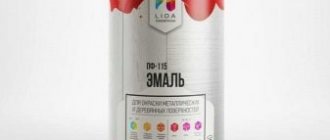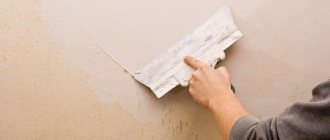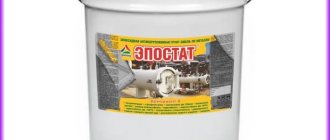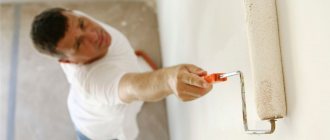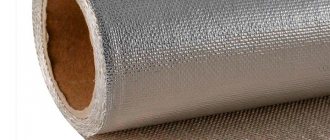Symptoms of poisoning
The following symptoms of acute paint poisoning are observed: blue skin, nausea, vomiting, confusion, dizziness, headache, cough, general weakness. A person may also experience a burning sensation in the eyes, ringing in the ears, and a sore throat. In addition, signs of poisoning characteristic of a specific paint component may be added to the general symptoms. For example, when inhaling acetone, the nervous system is affected. Externally, the clinic is similar to intoxication. When intoxicated with butyl acetate, a person experiences a burning sensation in the nasopharynx, mouth and eyes.
In the chronic form, general health worsens, mood decreases, nausea, heartburn appear, stool and sleep are disturbed. Chronic poisoning is also characterized by a nonproductive cough.
Research work: “The influence of paints on the human body”
Harmful substances contained in paints and varnishes can affect the human body through the respiratory tract, skin and digestive tract. Together with the air, vapors of solvents and an aerosol containing both solid particles and the liquid component of the paint enter the human lungs through the respiratory tract. At the same time, harmful substances that enter the body through the respiratory tract have a greater negative impact than when entering through the gastrointestinal tract, since in this case they enter the blood faster.
Paints and varnishes, like all chemical products, should be stored out of the reach of children. Even an aerosol can is dangerous in the hands of a child.
People with many years of experience in apartment renovation know that the smell of paint and varnish products is persistent and eats into surfaces and fabrics. The rooms where painting will be carried out should be completely cleared of furniture and other things. Choose water-based paint; it gives a high-quality coating and is practically odorless.
A special paint is produced for heating elements that does not emit toxic fumes when heated. While working, you should use a respirator, wear gloves to protect your hands, an old T-shirt and jeans that you don’t mind getting damaged by drops of paint. It is worth periodically ventilating the work area, tightly closing the jars with the substance, and cleaning used brushes and rollers with a special solvent outside.
Ventilation
Through ventilation during the day is a simple and effective method, but is suitable for use only in the warm season. In winter, you cannot open the windows for a long time, the rooms will become cold, and the paint will take longer to dry. You need to open windows and doors, and you can turn on several fans to speed up air circulation. The method allows you to remove the unpleasant odor in one day.
Wet sheets
Hanging wet sheets or towels will help remove lingering odors; the evaporating liquid will absorb paint molecules floating in the air. As it dries, you should thoroughly rinse the fabric you are using, wet it and hang it until the chemical odor is completely eliminated.
Buckets of water
An alternative to hanging wet fabric is wide and deep containers of cold water placed around the entire perimeter of the room. By intensively humidifying and opening windows to allow fresh air flow, pungent fumes will quickly dissipate.
Conditioning
An air conditioner with a special “air purification” function or with an ionization program will help remove the smell of paint in the apartment. A modern device sucks in contaminated air, passes it through built-in filters, removing any remaining paint fumes. Then he releases it back, clean and fresh.
To quickly get rid of the suffocating odor, you can use several methods, including the use of folk remedies.
To eliminate the stench from chemical dyes, simple substances and objects that can easily be found at home are suitable.
The pleasant smell of freshly brewed coffee can overpower the amber of paint and varnish products. To enhance the effect, you can place coffee beans or grounds from a drink in the room; as it is absorbed, it is worth updating the natural sorbent.
Ammonia
After the painted surfaces have dried, it is necessary to carry out wet cleaning. In 2 l. 10 ml of cool water should be added. ammonia and vinegar, then wipe the room with the prepared solution, including walls and radiators. After treatment, the room should be thoroughly ventilated.
Aroma oils
The use of essential oils helps remove toxic fumes from the home after renovations. You can place containers of water in the rooms and add a few drops of lavender or mint oil. A good effect is achieved by using a moisturizer with the addition of concentrated herbal extracts. You can remove volatile vapors using an oil lamp; they will disappear along with the fragrant smoke.
Activated or picnic charcoal are considered an accessible sorbent that perfectly absorbs toxic fumes. The product used should be placed in an enamel container and placed indoors. Change the coal several times until the evaporation is completely eliminated.
Onion and garlic
When these vegetables are cut, special substances, phytoncides, are released. Their strong aroma can protect against pathogenic bacteria floating in the air and hide the smell of paint. Chopped onions and garlic are laid out in flat plates that need to be placed in the rooms. After a few hours, the room needs to be ventilated.
Bright and juicy fruits smell pleasant, which is important after repairs. The lemon should be cut into slices and placed around the perimeter of the room, and as it dries, prepare fresh slices again. To obtain a long-lasting effect, you can spread citrus peels on heating devices.
This method involves applying baking soda to the carpet, upholstered furniture or clothing to remove stubborn odors. Apply the powder and leave for 24 hours; after the procedure, you need to thoroughly vacuum the carpet or sofa, and shake your clothes to remove any residue.
Wax candles will cope with the residual odor from paints and varnishes; the remaining volatile vapors are burned in an open fire. When using this method, you should strictly follow fire safety precautions, keep the doors to the room open and do not leave lit candles unattended.
If there is a high concentration of toxic substances in the room, you should turn to professional air purification methods.
Danger of paint poisoning
When intoxicated by paint vapors, the internal organs are primarily affected, the cardiovascular and respiratory systems are affected. In the absence of the opportunity to provide urgent medical care, a person may develop certain disturbances in the functioning of the body. Blood pressure levels decrease and heart rate increases. Thus, the body ensures adequate blood supply. As a result, cardiovascular failure may occur.
Respiratory failure may occur due to burns of the mucous membranes. If the paint gets inside the body, the esophagus and stomach are affected. The pancreas suffers from this and problems with the kidneys and liver develop. In addition, the victim's vision may be impaired, as paint vapors irritate the mucous membrane of the eyes.
Safe option
The market for paints and varnishes is constantly evolving. An example of a paint that does not have an active odor and has an organic composition is powder paint. This material is not dangerous even for use in a children's room.
The use of powder materials is permitted for painting furniture and walls. Unlike acrylic paint, painting using powder types of paints and varnishes is more economical.
The composition does not contain volatile harmful substances that can enter the human respiratory tract and lead to poisoning, which makes powder paints a universal product. The absence of odor reduces the time during which it is dangerous to stay in the room.
Surfaces painted using powder materials do not emit compounds hazardous to humans, even when heated strongly. Rapid drying of powder materials reduces the time of contact with paint and, accordingly, reduces the risk of poisoning.
Painting should be carried out with paints that do not have an active odor (or none at all) and have the most natural composition. The use of protective equipment is mandatory. Then poisoning can be avoided.
Help with paint poisoning
If a person experiences at least one of the alarming symptoms while working with paint, they should immediately take precautions. First of all, immediately leave the room and go outside. If this is not possible, then you need to open all the windows and doors to create a draft. In this case, the victim must be covered with a blanket, since heat is necessary in case of poisoning. You should also provide the person with water.
You need to drink as much as possible, since all toxins are removed from the body along with the liquid. It is important to remember that the drink must be warm. You can simply give clean water or herbal infusion. It wouldn’t hurt to give you a few tablets of activated carbon to drink. Doctors recommend drinking a solution of smecta in case of poisoning.
Smecta is a sorbent that removes toxic substances from the body. You should drink it throughout the day. It is important to understand that in case of poisoning you should consult a doctor even if the victim’s condition has returned to normal. Only a specialist can correctly assess the degree of intoxication and prescribe the necessary treatment.
If a person is unconscious, he should be placed on his side. To bring the victim to his senses, he is given a stable position and cotton wool soaked in ammonia is brought to his face.
When the victim does not come to his senses, and his breathing slows down or is not felt at all, artificial respiration should be performed immediately. If the pulse cannot be felt, then you need to start chest compressions. The ideal option is if both massage and artificial respiration are performed by 2 people at once. A person’s life depends on these actions in an emergency.
In a medical facility, the victim is provided with all necessary assistance. First, a full examination is carried out to identify complications. Doctors also need to find out what toxins have entered the body. This is necessary for treatment - depending on the components of the paint, a specific therapy is prescribed.
In addition, in a hospital setting, the patient is given glucose or saline, the stomach is washed, and all necessary measures are taken to cleanse the lungs of toxic substances. Drugs that support the functioning of the heart and blood vessels are also prescribed. Additionally, vitamin therapy is carried out.
Best materials of the month
- Coronaviruses: SARS-CoV-2 (COVID-19)
- Antibiotics for the prevention and treatment of COVID-19: how effective are they?
- The most common "office" diseases
- Does vodka kill coronavirus?
- How to stay alive on our roads?
How to avoid intoxication
When working with paints and varnishes, you should strictly follow safety rules, for example, use a mask. It should fit snugly to the nose and provide reliable protection for the mouth.
As soon as during work you notice an unpleasant odor coming from your mouth and the sensations in your nose begin to bother you, you should stop painting and leave the room.
In addition to a respirator, gloves and goggles should be used.
Painting of furniture is carried out exclusively in a thoroughly ventilated room specially designed for this purpose.
Protective measures also include choosing safe paint. For a children's room, for example, you should choose water-based materials. Walls and ceilings can be painted with acrylic paint. This can also be done in rooms where allergy sufferers live. In children's rooms, it is allowed to use material that has a photocatalytic effect - specially selected components of natural origin react with light, make the air free of volatile organic substances, disinfect it, destroy bacteria and odors.
If you plan to paint children's furniture, the recommendation to use water-based paints or acrylic paint remains relevant.
Choosing safe paint for your home
Time and again the question is raised about the content of harmful substances in paints and varnishes that negatively affect human health and the environment. According to Wikipedia, the total annual consumption of paints in Russia is about 1 million tons according to the Federal State Statistics Service. It is difficult to imagine how much the incidence of diseases caused by toxins and harmful substances would increase if all these paints were as harmful as skeptics say.
We recommend reading: Children's Metro Ticket Price
Look also at the base composition of the paint. Most often, safe paints used indoors contain water as a solvent (these include so-called water-based or water-dispersion paints, acrylic, latex paints, etc.). In Europe, where the safety of building materials is enshrined at the legislative level, the share of production of water-soluble paints is over 80% (compare with the figure for Russia: 30-40%). By the way, even alkyd enamels and varnishes based on non-aqueous solvents from certified European manufacturers are not harmful either to nature or to humans.
Russia is still lagging behind
In European countries, there is already an acute problem in the use of the paint and varnish industry in human life. Whereas Russia has not yet seriously faced this problem. As a result, it turns out that we are still varnishing or painting the pipeline system, even though this may become dangerous in the future for the next generation.
Because as a result of high humidity and low temperatures, which are characteristic of Russia, condensation forms, which has a destructive effect on metal products. It turns out that they need to be covered with a protective material, and this, in turn, has a negative impact on the ecological balance on the territory of the Russian Federation.
Table. .
| Pollutant | Maximum permissible concentration, mg/m3 | Pollutant | Maximum permissible concentration, mg/m3 | ||||
| working area | maximum one-time | average daily | working area | maximum one-time | average daily | ||
| Nitrogen dioxide | 5,0 | 0,085 | 0,085 | Benzene | 5,0 | 1,50 | 0,80 |
| Ammonia | 20 | 0,20 | 0,20 | Dichloroethane | 10 | 3,0 | 1,0 |
| Acetone | 200 | 0,35 | 0,35 | Sulfur dioxide | 10 | 0,5 | 0,05 |
| Hydrogen sulfide | 10 | 0,008 | 0,008 | Methanol | 5,0 | 1,0 | 0,5 |
| Phenol | 5 | 0,01 | 0,01 | Fluoride compounds (in terms of fluorine) | 0,5 | 0,02 | 0,005 |
| Formaldehyde | 0,5 | 0,035 | 0,012 | Non-toxic dust (limestone) | 6 | 0,5 | 0,05 |
| Chlorine | 1,0 | 0,10 | 0,03 | Ethanol | 1000 | 5 | 5 |
This video is unavailable
Let's do a quick test. Think about an airplane. What colour is he? White? Not surprising, since almost all of them are white. Of course, this does not apply to all aircraft. There are also colored ones. For example, the South African airline Mango paints its planes bright orange. And there is also the Russian airline S7, whose planes are bright green.
But they are all rather exceptions. The general rule is: “It’s better to paint the plane white!” But why? There are several reasons for this. For example, did you know that birds are less likely to crash into light-colored planes than dark ones? Time codes:
AutoJurist legal assistance
In fact, plastic is harmful in almost all forms, but plastic panels cause the most harm to health if they are used in a room where high temperatures reign: for example, a kitchen. Heat contributes to the release of toxic dioxin, the same applies to low-quality plastic windows, so the best option for finishing with plastic is a corridor or hallway, but not a living room or kitchen.
Reinforced concrete is also not the best choice; it can shield electromagnetic radiation, and unscrupulous builders sometimes use rocks with a high radioactive level in concrete, so one can only dream of comfort in such a structure. And this is not counting the fact that over time, radioactive gases thorium and radium begin to be released from such reinforced concrete. 4. Polyurethane foam. Insulation, friezes, moldings, sockets and other products are made from it. Polyurethane is a gas-filled plastic, the production of which releases carbon dioxide and polyol. It is believed that polyurethane foam is quite stable, but it cannot be used in large quantities, especially if the premises are residential. Insulation is carried out from the outside of the house or apartment to avoid harmful fumes. 5. Expanded polystyrene and polyurethane.
We recommend reading: Military lawyer Moscow where they teach
Prevention measures
Home textiles and upholstered furniture absorb the smell of paints and varnishes well. It will be difficult to remove it even with the help of professional means. To make it easier to ventilate the room after renovation, you need to take preventive measures:
- free up space for work as much as possible by moving furniture, household items and decor to other rooms;
- if it is impossible to rearrange heavy furniture, then cover it with plastic wrap and clear the shelves of things and books;
- do not dry laundry and other things on a closed balcony or loggia, which is combined with a painted room;
- carry out painting with the windows open;
- after completing the work, use a weak solution of vinegar or ammonia to wipe the floor in the apartment;
- immediately after finishing, remove brushes, rollers and other tools, wash them with solvent in a well-ventilated area or outside;
- Do not bring back furniture and home textiles while the room smells of paint.
Water-based paint for walls: acrylic, silicone, silicate, mineral
Large manufacturers produce coatings in accordance with GOSTs and standards under the control of government agencies. Among the well-known brands are the following: Tikkurila, Osmo, Tex, Marshall Maestro, Beckers, Finncolor, Bekkerplast, Belinka, Dulax.
- Components that make up water-based wall paint. The composition may contain fillers, thickeners, latex, antiseptics. You should not use paint if it contains phenol. Even in small quantities it can cause poisoning and provoke the development of cancer.
- Paint consumption per 1 m² of wall. The smaller this characteristic, the more economical it will be to paint the walls.
- Viscosity of the composition. The higher this indicator, the less water is added to the composition. The standard viscosity is 40–45 for brush application and 20–25 for spray gun application.
- Weight. The standard indicator is 1.35 kg/l.
- Time for complete drying. The performance indicator indicates the time it takes for the paint to completely dry on the walls. The indicator depends on the humidity and temperature in the room. At a temperature of +25 degrees and a humidity of no more than 60%, the composition dries from 4 to 10 hours.
Harm from cosmetics on the human body
— It also contains bronopol. This chemical is a derivative of formaldehyde. It is added to face creams and deodorants. Its concentration should not be higher than 1%. Otherwise, health problems may arise. It can often be found in the preparations of the Swedish company Oriflame, in Russian and Belarusian cosmetics. That's it... in pursuit of money, native producers are still in the same place.
Cosmetics for the face, body, arms and legs... how can you do without them? Every woman knows that proper nutrition, sports, daily skin care - all this is necessary to preserve youth and beauty and occupies an important place in the life of each of us. This is the way we are made, that we vitally need to like it.
What harm can the smell of paint cause?
The danger of fumes has been studied and proven for a very long time. When the paint begins to evaporate, the human body is exposed to tiny particles of acetone necessary to maintain the substance in a liquid state. Their effect on the body is manifested by the following symptoms:
- the occurrence of headaches, alternating and supplemented by the occurrence of hallucinations: the reaction is associated with the effects of toxic substances on the respiratory organs and, as a consequence, the human central nervous system;
- the appearance of vomiting or diarrhea;
- breathing may become difficult, which indicates a burn to the pathways;
- the eyes also suffer from paint, this manifests itself in the form of tension, burning and increased pain in the head;
- Sometimes anaphylactic shock occurs.
An air ionizer turned on during repairs will help you avoid health consequences when painting.
To help a person who has been poisoned by dyes, you need to do the following:
- Provide air access to the victim; it is advisable to take him outside.
- Organize drinking in sufficient quantities to help the body cope and cleanse itself of harmful fumes.
- Put the person to bed and provide him with peace.
- Take activated carbon in the required dosage.
- If necessary, show the victim to a doctor.
Review of specialized odor eliminators
You can get rid of the unpleasant smell of paint in your home using absorbents:
- Available options include silica gel - granules for filling cat litter. This substance absorbs the very cause of the odor, purifying the air in the room.
- An expensive product is a sorbent for the refrigerator. It is made from a mineral called zeolite. Its main property is to remove the concentration of gaseous substances. Zeolite granules are packaged in small boxes, they should be opened and placed in a bad-smelling room for several days.
- An industrial ozonizer effectively purifies the air in an apartment. Ozone is a powerful oxidizing agent that destroys pathogens and toxic chemical elements.
During painting work, toxins from dyes are absorbed into the coating of walls, wooden partitions, and cabinets. These surfaces will gradually release harmful substances that can harm the body, they are especially harmful to a small child. After renovation, it is recommended to constantly ventilate the room and carry out regular general cleaning using natural cleaning products.
Why is zinc production harmful to the human body?
Few people know, but it turns out that the effect of vitamin A largely depends on whether there is enough zinc in the body, since it activates the work of the vitamin and organizes its movement through the blood vessels to every cell of the body. Foods containing zinc: pay attention to seafood Large amounts of zinc are found in the pituitary gland (the main endocrine gland in our body), other endocrine glands, liver, skeleton, nails and hair.
We recommend reading: Waybill for the Director on a Company Car
Is zinc harmful? Professor Jay von Fraunhofer led a study examining the beneficial effects of zinc on the body. But is zinc harmful? As a result of experiments, it turned out that this chemical element also has an extremely negative effect on humans.

